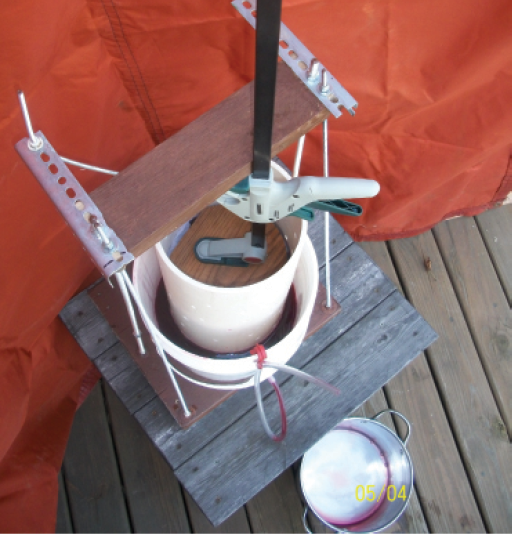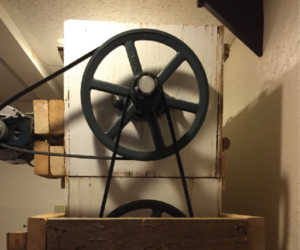 This project started when I got married. It suddenly became unacceptable to squeeze grapes like my mom did, in a flour sack hanging from a hook in what was now my wife’s kitchen ceiling. I saw the need for a fruit press that was easy to hide when not in use. The key part of this project was to discover ratcheting reverse acting bar clamps at my local lumberyard. For this project I picked a 24-inch (61-cm) reverse acting clamp that could give 350 pounds (159 kg) of force. To the extent that I could, all food contact surfaces can be sanitized (plastics, or better yet, stainless) since this tool is also used as a filter press to remove liquid from the fruit pulp at the end of a primary fermentation. Most of the materials needed to build this press are available at a big box hardware store. In my case many of the materials were scraps found at a Habitat for Humanity ReStore. My total cost was a $20 bar clamp and about $20 for everything else.
This project started when I got married. It suddenly became unacceptable to squeeze grapes like my mom did, in a flour sack hanging from a hook in what was now my wife’s kitchen ceiling. I saw the need for a fruit press that was easy to hide when not in use. The key part of this project was to discover ratcheting reverse acting bar clamps at my local lumberyard. For this project I picked a 24-inch (61-cm) reverse acting clamp that could give 350 pounds (159 kg) of force. To the extent that I could, all food contact surfaces can be sanitized (plastics, or better yet, stainless) since this tool is also used as a filter press to remove liquid from the fruit pulp at the end of a primary fermentation. Most of the materials needed to build this press are available at a big box hardware store. In my case many of the materials were scraps found at a Habitat for Humanity ReStore. My total cost was a $20 bar clamp and about $20 for everything else.

The press base turned out to be pieces of 2 x 8 (5 x 20 cm) glued together creating a 14 x 14-inch (36 x 36-cm) square. For extra strength the ends were reinforced with slotted angle. The sides are two pieces of 3⁄8-inch threaded rod (rated 600 pounds/272 kg tension). The bar for the top is 12 inches (30 cm) of an oak 2 x 4 (5 x 10 cm) (yes this sets up a triangular shape). The top bar was set at 27 inches (69 cm) of clearance. Triangles give strength, so the ends of the top bar also got two pieces of slotted angle and then three 1⁄4-inch rods were angled between the top and bottom corners. To finish, there is a bar clamp in spreading mode and I have circles of vinyl flooring that cushion/flatten the spot where the collection pail is.
The current “press basket” is a 20-inch (50-cm) length of 8-inch (20-cm) diameter PVC pipe (burst strength rated at 250 pounds/113 kg). This is lined with a 26 x 26-inch (66 x 66-cm) fine mesh nylon straining bag that I use as a rough filter. I drilled drainage holes spiraled in 1⁄2-inch steps from the bottom to about 2 inches (5 cm) from the top of the pipe. This resulted in a 3.6-gallon (13.6-L) tube. For a top surface to press against, I first created an 8-inch (20-cm) plastic circle (in an earlier life a plastic cutting board) and several additional oak pressure plates giving a strong surface to push on. The juice is collected in a recycled food pail. A drainage tube is attached to the bottom and can be lowered to empty the juice. Some of the old wooden presses I have seen have drainage channels under the basket. The plastic mesh (formerly spacers in pizza boxes) allows
bottom drainage.
In operation, the press basket with nylon bag fits into the juice collection bucket. The fruit is filled into the straining bag, which is folded over and covered with the round plastic and then wood pressure plate. The bar clamp is then installed and pressure is applied to the fruit. As juice weeps out, every ten minutes or so, the bar clamp is pumped again until I have pressed the fruit down to about 20% of the original volume. To do larger volumes such as a 6-gallon (23-L) carboy I will do a few cycles of pressing, open up the system, add more fruit to the nylon bag, reassemble, and then press some more.
My first press basket was a 6-inch (15-cm) diameter by 20-inch (51-cm) long PVC pipe, 1.2-gallon (4.5-L) volume. (The 6-inch/15-cm pipe is a perfect fit for a 10 x 22-inch/25 x 56-cm fine mesh nylon straining bag.) The 6-inch (15-cm) pipe was sufficient when I had only two grape vines or only grew enough raspberries for 3-gallons (11-L) of juice. One impression from testing shapes of different presses was that a fatter press basket takes longer for the juice to weep out. I favor length to give a higher capacity press, and this press has been sufficient for my capacity.
T






